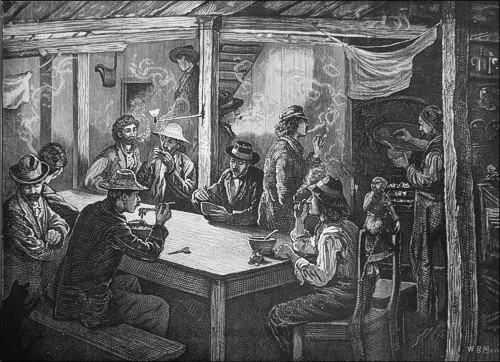|
|
 |
|
| The Italian Organ-Grinder, The Illustrated London News 1881 |
|
|
|
|
La percezione inglese degli italiani, una colonia numerosa nella Londra ottocentesca, tendeva a essere confusa ed equivoca. In Italia i nobili discendenti degli antichi greci e romani si rivelavano, spesso, briganti o semplici contadini. In Gran Bretagna, invece, nella prima metà del secolo emergevano le figure di esuli colti, esponenti di una cultura musicale e letteraria molto apprezzata, mentre nel secondo Ottocento l’immaginario popolare si focalizzava su mendicanti, musicisti e venditori ambulanti poco affidabili: gelatai d’estate e caldarrostai d’inverno.
A causa di questi stereotipi Oltremanica, se non erano di buona famiglia, gli artisti rischiavano di essere quasi disprezzati. Di questi, poi, alcuni aspiranti ma ancora sconosciuti, subivano un altro umiliante confronto col passato: “Ci lapidano coi grandi nomi antichi” si lamentava Nencioni, “ci guardano dall’alto in basso, perché in Firenze non c’è più Michelangelo”. I dipinti macchiaioli di Telemaco Signorini furono giudicati “non-finiti” e le innovazioni scapigliate di Daniele Ranzoni furono addirittura rifiutate dalla Royal Academy, nonostante entrambi avessero successo con alcune committenze private. In compenso, gli artigiani italiani furono molto apprezzati specie come doratori di cornici e fabbricanti di specchi.
Difficoltà non indifferenti sorgevano poi con la lingua e con il cibo, che gli italiani trovavano indigesto; mancava inoltre il buon bere italiano. Senz’altro per questo motivo gli artisti italiani prediligevano ritrovi gestiti da connazionali: la trattoria Pagani, i ristoranti dei fratelli Gatti, il caffè Monico e Romano’s, solo per citarne qualcuno. Tra l’altro la ristorazione era ed è tutt’ora un’eccellenza italiana: altri sei ristoranti italiani erano registrati sul Baedeker nel 1899. Tra gli alberghi preferiti figuravano l’hotel Previtali, in Arundell Street e l’Hotel Piemonte, dei fratelli Mentasti.
Comunque, se l’avversione per la cucina inglese era superabile, non lo era certo per il clima uggioso. La nebbia che tanto piaceva a Mazzini, cinquant’anni dopo fu denunciata come danno sociale da Paolo Valera e Grubicy si lamentava che l’aria sporca rovinava i dipinti esposti. Per Ranzoni, e per molti altri, Londra era una città di smog: “… e quando si vede il sole”, scrisse, “come l’è sbiadito…”.
Spaesati e depressi, molti italiani sognavano un rapido ritorno in patria, anche perché non riuscivano a integrarsi nella vita sociale inglese con tutto il suo protocollo. Mentre Boldini era stato in grado d’inserirsi con eleganza nell’alta società britannica, il carattere rude e indisciplinato di Mancini lo aveva emarginato. Tra l’altro, per questi artisti, l’ingresso ai club inglesi era proibito, eccezione fatta per l’Arts Club, al quale solo Carlo Pellegrini, Giuseppe De Nittis ed Ettore Tito furono ammessi. Cecioni, forse, vi cenò qualche volta.
|
|
|
The British perception of the Italians, who formed a numerous colony in Victorian London, tended to be equivocal. In Italy, the noble desecendants of the ancient Greeks and Romans often proved to be brigands or simple peasants. In Great Britain, on the other hand, at least in the first half of the century, the Italian exiles who came to the fore were frequently exponents of a musical and literary culture much appreciated. In the second half, the popular image focused on beggars, strolling players or untrustworthy pedlars, who sold ice cream in summer and chestnuts in winter.
Because of these contrasting Victorian stereotypes, the Italian artists risked being disregarded if they were not of respectable social extraction. Moreover, on another level, the aspiring but yet unrecognised artists underwent a further, humiliating confrontation with the past. “They stone us with the great names of the Old Masters”, complained Enrico Nencioni, “They look down on us from on high, because there is no longer a Michelangelo in Florence.” The “macchiaiolo” paintings by Telemaco Signorini were considered unfinished, and the “scapigliato” innovations of Daniele Ranzoni met with straight refusal from the Royal Academy, despite both artists enjoying some success with private clients. On the other hand, Italian artisans were highly prized, especially for the quality of their carved gold frames and looking glasses.
Difficulties arose over the language, and the English food, which Italians found indigestible; good Italian wine was not to be had. Probably for this reason, the Italian artists preferably frequented premises run by their compatriots: Pagani’s restaurant, the cafè Monico and Romano’s, to mention only a few. As still today, Italian cuisine was a national excellence, and the Baedeker for 1899 listed a further six Italian restaurants London. One of the principal hotels preferred by the Italians was the Hotel Previtali, in Arundell street, and another the Hotel Piemonte, run by the Mentasti brothers.
However, if it was possible to overcome an aversion for English food, it was not so easy to tolerate the humid English climate. Paolo Valera denounced the fog, which had appealed so much to Mazzini fifty years before, and Vittore Grubicy complained that the polluted atmosphere ruined paintings on exhibition. For Ranzoni, as for many others, London was a city of smog: “…and when you see the sun”, he wrote, “how terribly faded it is…”
Depressed and out of their element, many Italians dreamed of a fast return home, not least because they failed to enter into English social life, and negotiate all its protocol. Whereas Giovanni Boldini was able to integrate himself with elegance into British high society, Antonio Mancini found himself emarginated because of his uncouth and undisciplined character. Amongst other things, for these artists admittance to the traditonal Clubs was barred, except for the Arts Club, to which only Carlo Pellegrini, Giuseppe De Nittis and Ettore Tito acceded. Adriano Cecioni perhaps dined there once or twice.
|
|
|
|
|
|